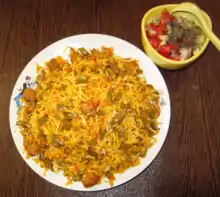Shirazi salad
Shirazi salad (Persian: سالاد شیرازی sālād shirāzi)[1] is an Iranian salad that originated from and is named after Shiraz in southern Iran.[2][3][4] It is a relatively modern dish, dating to sometime after the introduction of the tomato to Iran at the end of the nineteenth century.[5] Its primary ingredients are cucumber, tomato, onion, olive oil, herbal spices and verjuice, although lime juice is sometimes used in its preparation.[1][6] In Iran, it is eaten in the summer as a side dish on its own, and year-round as a side dish alongside meat-based foods such as kebab[6][7][8] or steak, and as a side dish before and after meals.[9] Shirazi salad is sometimes served as an accompaniment to rice.[10] Cookbook author Jila Dana-Haeri describes it as a refreshing dish during the summer.[2]
Shirazi salad has been described as being akin to a national salad in Iran, and it is a common meal accompaniment.[3] It may also be used in a manner similar to that of a condiment, to reduce the spiciness of stews.[11] It typically has a crisp and moist texture,[1][12] and is somewhat similar to pico de gallo and Israeli salad.[8][13]
Ingredients

The primary ingredients of Shirazi salad consist of small, finely-diced cucumber, tomato and onion, which is mixed with verjuice (or sometimes fresh lemon or lime juice) and some dried mint.[1][2] Olive oil, salt, and pepper may be used,[2][3] and additional ingredients may include chopped mint, parsley, scallions, dill, sumac, and red vinegar.[8][9] The salad may have a sour and salty flavor, and its flavor may increase after being set for an hour or longer before serving, which allows time for the flavors to intermingle.[2] It may be served with breads such as pita and lavash,[6] or with cheese and/or walnuts.
See also
References
- Shafia, L. (2013). The New Persian Kitchen. Potter/TenSpeed/Harmony. p. 59. ISBN 978-1-60774-358-3. Retrieved October 31, 2015.
- Dana-Haeri, J.; Lowe, J.; Ghorashian, S. (2011). New Persian Cooking: A Fresh Approach to the Classic Cuisine of Iran. I.B.Tauris. p. 181. ISBN 978-0-85771-955-3.
- "Shirazi salad". The Irish Times. March 21, 2013. Retrieved October 31, 2015.
- Vartanian, A.; Kubal, A.; Wolfe, L. (2014). The Paleo Foodie Cookbook: 120 Food Lover's Recipes for Healthy, Gluten-Free, Grain-Free & Delicious Meals. Page Street Publishing. p. 217. ISBN 978-1-62414-049-5.
- Chehabi, H. E. (2003-03-01). "The Westernization of Iranian Culinary Culture". Iranian Studies. 36 (1): 43–61. doi:10.1080/021086032000062875. ISSN 0021-0862.
- Raichlen, S. (2008). The Barbecue! Bible 10th Anniversary Edition. Workman Publishing Company. p. 118. ISBN 978-0-7611-5957-5.
- "Caspian Grill's chicken kabobs with basmati rice and shirazi salad". C-J Recipes. March 8, 2012. Retrieved October 31, 2015.
- Stewart, B.; Edwards, D.; Warner, J. (2013). Paleo Fitness: A Primal Training and Nutrition Program to Get Lean, Strong and Healthy. Ulysses Press. p. 251. ISBN 978-1-61243-207-6.
- Reid, S. (2006). Fitting Into Your Genes: Healthy Living And Eating in Philadelphia. Peconic Press. p. 165. ISBN 978-0-9768176-2-8.
- Kelly, Rachel (August 26, 2014). "18 recipes for leftover mint". the Guardian. Retrieved October 31, 2015.
- "A Persian feast". www.ajc.com. October 15, 2015. Retrieved October 31, 2015.
- "Shirazi Salad Recipe". Bon Appétit. May 5, 2013. Retrieved November 11, 2015.
- Eshghi, Abrisham (June 30, 2013). "Time for Israelis and Iranians to rediscover their similarities - Opinion". Haaretz.com. Retrieved October 31, 2015.
Further reading
- Onion, Medium Spring; Sliced, Thinly (May 5, 2013). "Shirazi Salad". Bon Appétit. Retrieved October 31, 2015.